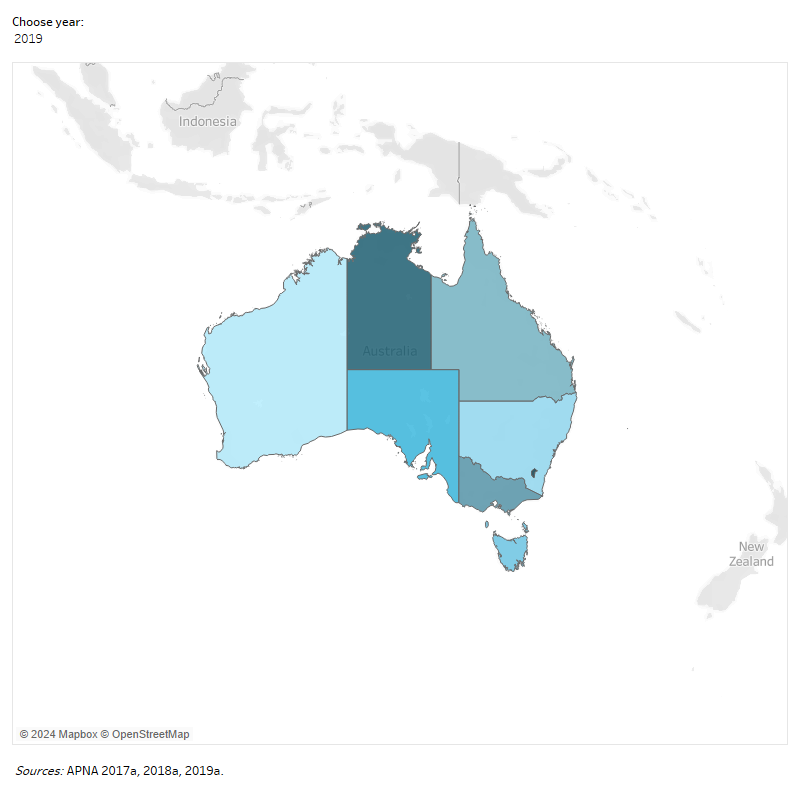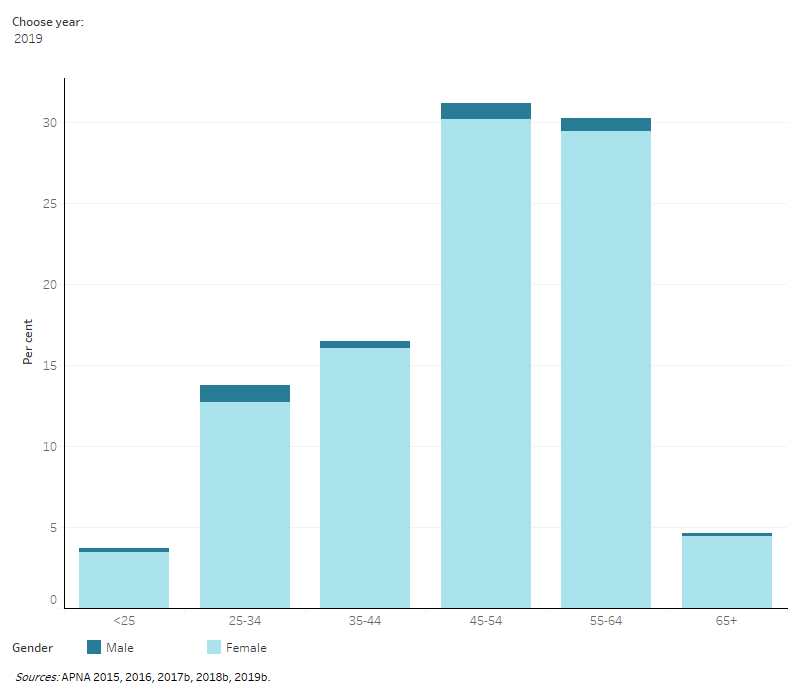Primary Health Care Nurses
The Australian Primary Health Care Nurses Association
The Australian Primary Health Care Nurses Association (APNA) is the peak professional body for nurses in primary health care in Australia. They have a large and growing membership that represents primary health care nurses living and working across Australia.
APNA supports the role of primary health care nurses by advancing professional recognition, ensuring workforce sustainability, nurturing leadership in health, and optimising the role of nurses in patient-centred care.
This report summarises data from APNA membership registration, and annual APNA surveys.
The APNA Survey
Since 2004, the APNA has commissioned an annual survey which aims to elucidate the wide range of conditions and work-place issues facing primary health care nurses working in Australia. The survey was administered to current and past APNA members and to contacts from a further 60 stakeholder organisations. The AIHW analysis included those respondents who identified as a nurse or a midwife working in primary health care as their primary or secondary place of employment, and excluded those who were working exclusively in the acute hospital setting.
Survey respondents participated from major cities to rural and remote areas across Australia. The survey aims to equip nurses working in primary health care with information on the conditions of their profession (APNA & HPB 2018).
Where do primary health care nurses live?
Registered members of APNA represent primary health care nurses living and working across Australia. In 2019, the highest proportion of APNA members lived in New South Wales (33%), Queensland (23%) and Victoria (22%) (Figure 1).
Figure 1: APNA membership proportion by state, 2017–2019
Alternative Text for Figure 1: The figure shows APNA membership data for the period 2017–2019. Over the whole period, the majority of APNA members resided in New South Wales, Queensland and Victoria. In 2019, 33% of members lived in New South Wales, 23% lived in Queensland and 22% lived in Victoria. Only 1% and 2% of members lived in the Northern Territory and the Australian Capital Territory.

Who are primary health care nurses?
According to the APNA Survey, 60% of primary health care nurses were aged between 45 and 64 years of age in 2019. The average age in 2019 was 48 years (Figure 2). From 2015–2019, the vast majority of respondents were women, reflecting the high proportion of female nurses in Australia (ACN 2019).
Figure 2: Gender and age distribution of primary health care nurses, 2015–2019
Alternative Text for Figure 2: The figure shows the age distribution of respondents, by gender between 2015 and 2019. Over this period, the highest proportion of respondents were in the 45 to 64-year age categories. In 2019, 61% of respondents were in the 45 to 64 year age group.

Most primary health care nurses were registered nurses
Most primary health care nurses were registered nurses (82%), followed by enrolled nurses (9%) in 2019. These proportions were similar across the survey years, between 2015 and 2019 (Figure 3).
Figure 3: Registration status of primary health care nurses, 2015–2019
Figure 3 Alternative text: The figure shows the registration status of respondents between 2015 and 2019. The highest proportion of responses within each year were from registered nurses, followed by enrolled nurses, nurses and midwives, and nurse practitioners. In 2019, 82% of respondents were registered nurses, followed by enrolled nurses (9%).

The majority of primary health care nurses were qualified in Australia
Almost 9 out of 10 (86%) primary health care nurses received their initial nursing or midwife qualification in Australia in the 2019 survey. In this same year, 14% of nurses reported first qualifying outside of Australia, reflecting the diverse background of the nursing profession (Ohr, Brazil & Holm 2018). For those whose initial qualification was obtained outside Australia, the highest proportion occurred in the United Kingdom and New Zealand (Figure 4).
Figure 4: Country group of first qualification as a nurse/midwife among primary health care nurses, 2016–2019
Figure 4 Alternative Text: The figure shows the top 6 country groups (minor) where respondents completed their first qualification, between 2016 and 2019. Over this period, Australia was the highest country group, followed by the United Kingdom and New Zealand.

References
ABS (Australian Bureau of Statistics) 2016. Standard Australian Classification of Countries (SACC). ABS cat. no. 1269.0. Canberra: ABS.
ACN (Australian College of Nursing) 2019. Men in Nursing: Why it’s okay for men to care Viewed 6 April 2020.
Australian Primary Health Care Nurses Association (APNA), 2020. What is primary health care nursing? Viewed 31 March 2020.
APNA 2017a. APNA Annual Report 2018. Melbourne: APNA.
APNA 2018a. APNA Annual Report 2018. Melbourne: APNA.
APNA 2019a. APNA Annual Report 2018. Melbourne: APNA.
APNA 2015. Microdata: APNA Workforce Survey, 2015. Melbourne:APNA. Findings based on AIHW analysis of APNA microdata.
APNA 2016. Microdata: APNA Workforce Survey, 2016. Melbourne:APNA. Findings based on AIHW analysis of APNA microdata.
APNA 2017b. Microdata: APNA Workforce Survey, 2017. Melbourne:APNA. Findings based on AIHW analysis of APNA microdata.
APNA 2018b. Microdata: APNA Workforce Survey, 2018. Melbourne:APNA. Findings based on AIHW analysis of APNA microdata.
APNA 2019b. Microdata: APNA Workforce Survey, 2019. Melbourne:APNA. Findings based on AIHW analysis of APNA microdata.
APNA & Health Professionals Bank, 2018. Workforce Survey report 2018 summary. Viewed 3 April 2020.
APNA 2020a. What is primary health care nursing? Viewed 31 March 2020.
Nursing and Midwifery Board Australian Health Practitioner Regulation Agency (AHPRA) 2020. Registrant data. Viewed 9 April 2020.
Ohr S, Holm D & Brazil S 2016. The transition of overseas qualified nurses and midwives into the Australian healthcare workforce. The Australian Journal of Advanced Nursing 34(2): 27–36.


